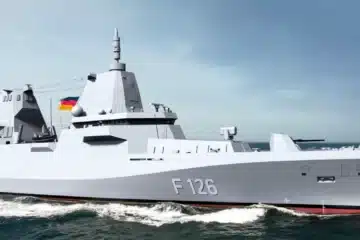The Sachsen-class frigate F221 HESSEN has departed Wilhelmshaven on February 8. The German anti-air warfare frigate will initially head for the Mediterranean, intending to pass trough Suez into the Red Sea once Operation Aspides comes into effect. The objective is to support military efforts protecting shipping against missile and drone-attacks by the Yemen-based Houthi militia. Siemtje Moeller, State Secretary for Defence under Defence Minister Boris Pistorius, bid farewell to the ship under the command Fregattenkapitaen Volker Kuebsch on Thursday morning.
“With Operation Aspides Europe is going to assume responsibility for the security of sea lanes in one of the most important trade routes for Germany and Europe.” Moeller said. The State Secretary expects an approval of Aspides by the European Council before February 19. A mandate for the mission by the German Bundestag is to follow. Berlin’s decision sending off “Hessen” ahead of political processes launching Operation Aspides is in lockstep with European partners. The Italian Navy on January 28 has quietly deployed her own Andrea Doria-class AAW destroyer “Caio Duilio”. The ship will operate under the scope of the existing EU mission Atalanta, until Aspides comes into force.
Sachsen-class considered only suitable combatant for mission

Germany presently operates three different types of frigates. These are the ageing F123 Brandenburg-class, notionally an ASW-design, but used for a variety of patrol missions. There are also the new F125-class Baden-Wuerttemberg-frigates, mostly focused on various low intensity combat-scenarios. Finally the three F124 frigates, built in the early 2000s, represent the “high end” of German naval capability. The ships are designed for fleet air defence utilising their APAR- and Smart L-radar systems. Armament includes SM-2 Blk III long range surface to air-missiles, ESSM for medium ranges and RIM-116 for close air defence.
Navy Chief Vizeadmiral Kaack and Hessen CO Kuebsch were empathetic on the ship being most suited for the mission. “As we are dealing with a high intensity-environment there, there’s only one ship suitable, with armament adequate to persist. (…) This frigate is our gold standard, so to speak.” Kuebsch echoed these sentiments: “The threat over there is not abstract anymore. It is real and includes a range of weaponry.” The Houthis have used a variety of capabilities against commercial shipping and naval combatants in the area. These include unarmed drones to obtain targeting information for antiship- and cruise missiles, but also ballistic missiles of various ranges. American, British and French destroyers and frigates have already intercepted Houthi-attacks against shipping.
German Navy again stretched thin by commitments and requirements

The “Hessen” has embarked a crew of 240 personnel. Beyond the standard complement it consists of support for two helicopters, a medical team and an unspecified number of “Seebataillon” naval infantry troops. The “Seebataillon” is likely sending of the “Bordeinsatzkompanien” specialised on boarding operations. For the ship this new deployment represents a somewhat frantic turnaround. “Hessen” was previously assigned to NATO SNMG1, then within the scope of the Very High Readiness Joint Task Force (Maritime) – VJTF(M) – until January 12. The frigate by Christmas last year had completed three major exercises within five months and travelled nearly 35,000 nautical miles in the process.
The deployment of the German anti-air warfare frigate may compel the country’s naval service to further revisit force posture requirements. The German Navy is aiming to transition from a fleet equipped for and primarily concerned with “show the flag”-assignments including within NATO, to a more robust force designed and equipped for engaging a wider range of kinetic threats. The four new F126-class joining service from around 2030 will somewhat improve combat capabilities. Nevertheless the Red Sea-deployment seems to illustrate the rapid change in threat environments. New missions including “Aspides” may put question marks on adequate specifications of German naval capability often expected to act as a first responder to multinational obligations abroad.






